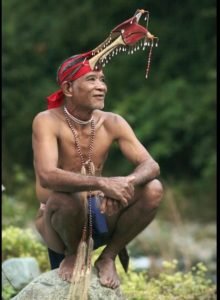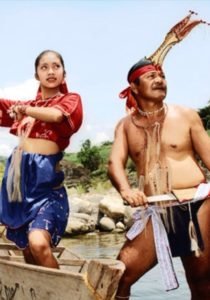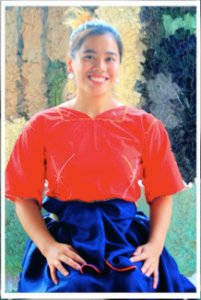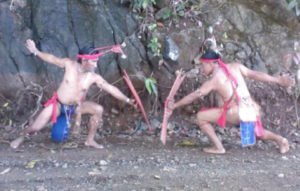 The “Bugkalot” like any other people have an innate pride in their unique culture. Outsiders and lowlanders often wonder why we unashamedly refer to ourselves as such. We call our tribe and language “Bugkalot” from the root word “Ka-lot” – meaning “interweave” or “interwoven”. Our lifestyle is generally interwoven as can be seen in the way we build our houses which must be interwoven with rattan. Our costumes and native attire must also be interwoven with many colorful decorations. Our artifacts too, are traditionally interwoven with rattan or bamboo and other endemic natural materials like feathers, animal fur, etc. The Bugkalot Tribe, more commonly known to lowlanders as “Ilongots”, are located in the Northern part of the island of Luzon in the Philippines, primarily in the provinces of Aurora, Nueva Ecija, Nueva Vizcaya, and Quirino. As of this year 2016, it has a population of more or less 15,000.
The “Bugkalot” like any other people have an innate pride in their unique culture. Outsiders and lowlanders often wonder why we unashamedly refer to ourselves as such. We call our tribe and language “Bugkalot” from the root word “Ka-lot” – meaning “interweave” or “interwoven”. Our lifestyle is generally interwoven as can be seen in the way we build our houses which must be interwoven with rattan. Our costumes and native attire must also be interwoven with many colorful decorations. Our artifacts too, are traditionally interwoven with rattan or bamboo and other endemic natural materials like feathers, animal fur, etc. The Bugkalot Tribe, more commonly known to lowlanders as “Ilongots”, are located in the Northern part of the island of Luzon in the Philippines, primarily in the provinces of Aurora, Nueva Ecija, Nueva Vizcaya, and Quirino. As of this year 2016, it has a population of more or less 15,000.
 Lately, we found out that we have some similarities to the peoples of the Bible. We are called by our first names and identified by using the names of our fathers & forefathers (ie.: Isaac the son of Abraham), like the genealogy of Jesus in the book of Matthew (Mt. 1:1 to 16). We are also called by our clans, as in “John iGumiad” (in English: John from Gumiad). One big mistake of the non-Bugkalot and even of the Anthropologists who lived with us in the villages is that they sometimes called us by using pseudo names like ‘italon’, ‘abacas’, ‘ibilao’. Those are the names of the places where our forefathers lived a long time ago. The meaning of ‘italon’ is rice-field, while ‘abacas’ is the name of the village in Abaca where our relatives live up to this time, and ‘ibilao’ is also a place where our relatives lived and which they have adopted as their family name: “Biyao”.
Lately, we found out that we have some similarities to the peoples of the Bible. We are called by our first names and identified by using the names of our fathers & forefathers (ie.: Isaac the son of Abraham), like the genealogy of Jesus in the book of Matthew (Mt. 1:1 to 16). We are also called by our clans, as in “John iGumiad” (in English: John from Gumiad). One big mistake of the non-Bugkalot and even of the Anthropologists who lived with us in the villages is that they sometimes called us by using pseudo names like ‘italon’, ‘abacas’, ‘ibilao’. Those are the names of the places where our forefathers lived a long time ago. The meaning of ‘italon’ is rice-field, while ‘abacas’ is the name of the village in Abaca where our relatives live up to this time, and ‘ibilao’ is also a place where our relatives lived and which they have adopted as their family name: “Biyao”.
 Just like the ancient peoples of the Bible, we use the names of the places where our ancestors lived, and adopted them to be our family names like: Pasigian, Gumiad, Tamsi, Benabe, Caanawan, Nangitog (Nangitoy), Budek, Deginat (Daguinat), Payupay, Peknag (Pacnal), Besilid, Biyao, Cabarroguis (which has been retained in the Philippine map) and others. These are all places that have been turned into clans’ names. In the 1950’s, some school teachers came to work in the nearby villages of the Bugkalot in order to teach our parents particularly in Caranglan of Nueva Ecija, Dupax Del Norte of Nueva Vizcaya, Kasibu of Nueva Vizcaya, Maria of Aurora Province. Those well-meaning teachers did not have much knowledge about anthropology, nor did they know about the history of the ancient peoples of the Bible (ex. “Si Abraham na taga Ur“). They insisted on getting the names of our forefathers or family names of our god fathers.
Just like the ancient peoples of the Bible, we use the names of the places where our ancestors lived, and adopted them to be our family names like: Pasigian, Gumiad, Tamsi, Benabe, Caanawan, Nangitog (Nangitoy), Budek, Deginat (Daguinat), Payupay, Peknag (Pacnal), Besilid, Biyao, Cabarroguis (which has been retained in the Philippine map) and others. These are all places that have been turned into clans’ names. In the 1950’s, some school teachers came to work in the nearby villages of the Bugkalot in order to teach our parents particularly in Caranglan of Nueva Ecija, Dupax Del Norte of Nueva Vizcaya, Kasibu of Nueva Vizcaya, Maria of Aurora Province. Those well-meaning teachers did not have much knowledge about anthropology, nor did they know about the history of the ancient peoples of the Bible (ex. “Si Abraham na taga Ur“). They insisted on getting the names of our forefathers or family names of our god fathers.
 The word “ILONGOT“, as a matter of fact is not from us. It was created by an outsider, but it was accepted in our tribe because we acknowledged its general meaning. Roughly translated as, “animists and head hunters”, it was an appropriate description of our forefathers’ practices. No Bugkalot student even attempted to explain to their teachers at that time. Sometimes, they didn’t even want to be identified as Bugkalot because they felt embarrassed and probably feared that they might be bullied.
The word “ILONGOT“, as a matter of fact is not from us. It was created by an outsider, but it was accepted in our tribe because we acknowledged its general meaning. Roughly translated as, “animists and head hunters”, it was an appropriate description of our forefathers’ practices. No Bugkalot student even attempted to explain to their teachers at that time. Sometimes, they didn’t even want to be identified as Bugkalot because they felt embarrassed and probably feared that they might be bullied.
BUGKALOT COMES INTO BEING
 The original and true tribal name “BUGKALOT” was declared as our official name, when the over-all organization of the Bugkalot clans, ‘Bugkalot Confederation’ was organized in 1967. Headed by our former Chieftain Molina Salvador, our elders agreed to use a name that comes from us, instead of ‘Ilongot’ which is not from us. Chieftain Molina said, “Ma Bugkalot siyay ma binangonan si” – meaning “Bugkalot is a name from us and to which we have awakened”. The term ‘Ilongot’ came around in the first half of the eighteenth century and is still being used up to this time. Due to the appropriateness of its meaning, it is still being used to call us as it is already recorded in many documents, internet and even in our Certificate of Ancestral Domain Title where we are defined as “Bugkalot/Ilongot”, for legal purposes.
The original and true tribal name “BUGKALOT” was declared as our official name, when the over-all organization of the Bugkalot clans, ‘Bugkalot Confederation’ was organized in 1967. Headed by our former Chieftain Molina Salvador, our elders agreed to use a name that comes from us, instead of ‘Ilongot’ which is not from us. Chieftain Molina said, “Ma Bugkalot siyay ma binangonan si” – meaning “Bugkalot is a name from us and to which we have awakened”. The term ‘Ilongot’ came around in the first half of the eighteenth century and is still being used up to this time. Due to the appropriateness of its meaning, it is still being used to call us as it is already recorded in many documents, internet and even in our Certificate of Ancestral Domain Title where we are defined as “Bugkalot/Ilongot”, for legal purposes.
Since time immemorial and as far as our forefathers can remember, the Bugkalot originated generally from Isabela, Nueva Vizcaya and Aurora Province. When the Spaniards came, the Bugkalot were roaming everywhere in the above mentioned provinces, and were lords of vast tracts of lands.  Though not many in number, we nonetheless covered a wide territory from Palanan to Southern Isabela down to eastern Nueva Vizcaya, which at the time of the Spaniards, included the place that is now known as Quirino Province; and from eastern Nueva Vizcaya to Aurora Province (formerly part of Quezon or Tayabas), then down to Pantabangan, Nueva Ecija”.
Though not many in number, we nonetheless covered a wide territory from Palanan to Southern Isabela down to eastern Nueva Vizcaya, which at the time of the Spaniards, included the place that is now known as Quirino Province; and from eastern Nueva Vizcaya to Aurora Province (formerly part of Quezon or Tayabas), then down to Pantabangan, Nueva Ecija”.
Nowadays, the Bugkalot are located mainly in Nueva Vizcaya, Quirino and Aurora Provinces. It has been a privilege and opportunity for a few of us who were able to finish a degree in college, to inter-marry with non-Bugkalot, and live elsewhere in highly urbanized cities, and even in other parts not just of the Philippine archipelago, but of the world. Our ancestors only thought of living in Nueva Vizcaya, Quirino, Aurora and Nueva Ecija which we consider as our home land, but according to the Anthropologist Laurence L. Wilson (who lived in Bugkalot country for some time in the 1940’s), we were “… Of Indonesian stock who  inhabited the Southern Sierra Madre and Caraballo Mountains.” He mentioned this in his book “Life and Legends of the Ilongots” (1967), He came to this conclusion due to the similarity of our costumes and attires with that of our Indonesian neighbors. Another anthropologist, Renato Rosaldo (who lived among the Bugkalot between 1967 to 1974), the Bugkalot are probably Malay because of their headhunting practice.
inhabited the Southern Sierra Madre and Caraballo Mountains.” He mentioned this in his book “Life and Legends of the Ilongots” (1967), He came to this conclusion due to the similarity of our costumes and attires with that of our Indonesian neighbors. Another anthropologist, Renato Rosaldo (who lived among the Bugkalot between 1967 to 1974), the Bugkalot are probably Malay because of their headhunting practice.
The Ethnologue lists them as an ethno-linguistic group whose language belong to the Austronesian, Western Malayo-Polynesian family of languages. Our thoughts never reached that far, and we generally feel that it is far from the truth. The Bugkalot have lost their vast territory.  Throughout the centuries other people have taken our lands or driven us away. First there were the Spaniards, then the Americans, and more recently the settlers (we call them migrants), have pressured and compressed the Bugkalot in the small space we occupy today. Now, even within this cramped space, the Bugkalot live as a small minority, surrounded by and vulnerable to exploitation by settlers from beyond our world.
Throughout the centuries other people have taken our lands or driven us away. First there were the Spaniards, then the Americans, and more recently the settlers (we call them migrants), have pressured and compressed the Bugkalot in the small space we occupy today. Now, even within this cramped space, the Bugkalot live as a small minority, surrounded by and vulnerable to exploitation by settlers from beyond our world.
Today, majority of the Bugkalot have settled in the Mountain areas that constitute the boundaries of the provinces of Isabela, Nueva vizcaya, Quirino, Aurora and Nueva Ecija. Our people are concentrated in that part of the Sierra Madre Mountain range along the Conwap, Casecnan, Taan and Abaca Rivers, near the head waters of the big Cagayan River. Most of the Bugkalot live near the forests of what the government calls Dupax Watershed and the Casecnan Watershed. It is here where we think we can find the great contribution of the Bugkalot to national development – the Casecnan Muti-purpose Irrigation and Power Project (CMIPP) operated by Cal Energy, Ltd., foreign company.
Pursuant to the 1987 Constitution, Republic Act No. 8371 and its Implementing Rules and Regulations, also known as the Indigenous Peoples Rights Act of 1997 (IPRA) empowers us to plan for the development, management, and utilization of our resources within the coverage of our Certificate of Ancestral Domain (Titles No. RO2-NAG-O703-0012) having a total land area of 139,691.61 hectares more or less, traversing the Municipality of Nagtipunan, Quirino; Municipality of Kasibu and Dupax Del Norte, Nueva Vizcaya; and Municipality of Maria Aurora and Dipaculao. Both CADC No. 22 & 23 have a total land area of 73,081.60 hectares more or less, traversing the Municipalities of Dupax Del Sur and Alfonso Castaneda of Nueva Vizcaya with an additional Direct CADT Application in between Quirino and Nueva Vizcaya currently being processed. The Bugkalot as the CADT holder/owner shall expedite its inter-generational responsibility and accountability in protecting our Ancestral Domains, institutions, customs, and cultural integrity. These are the only legacies passed on to us by our ancestors, though they were not able to enjoy its abundance.
The BUGKALOT are traditionally an animistic people with different names for their gods: in the field he is called “ioma” (god in the field/farm), in the water “pi-ngit“, on the ground “idegin“, in the forest “igongot” and others. But notably there is a higher being that they respect the most, they call him “BINANGONAN” – existent before they came into being, He is the ONE that has no beginning – the God whom they believe is their Creator.
